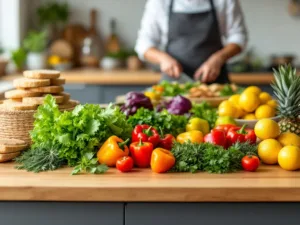Cooking with Seasonal Vegetables: How to Take Advantage of Each Season
Introduction
In a world where convenience often trumps quality, the art of cooking with seasonal vegetables is a timeless practice that not only enhances the flavor of your meals but also supports local agriculture and promotes sustainability. Seasonal vegetables are fresher, more nutritious, and often more affordable than their out-of-season counterparts. This article delves into the benefits of cooking with seasonal vegetables, provides practical tips for identifying and selecting the best produce, and offers a variety of recipes and techniques to help you make the most of each season’s bounty. Whether you’re a seasoned chef or a home cook looking to elevate your culinary skills, this guide will inspire you to embrace the rhythm of nature and transform your kitchen into a haven of seasonal delights.
The Benefits of Cooking with Seasonal Vegetables
Enhanced Flavor and Nutrition
One of the most compelling reasons to cook with seasonal vegetables is the superior flavor and nutritional value they offer. Vegetables that are harvested in their peak season are fresher and have had the opportunity to fully ripen on the vine or in the soil, resulting in a more robust and satisfying taste. For example, a summer tomato picked at the height of ripeness will have a sweetness and juiciness that is unmatched by a tomato grown in a greenhouse during the winter months.
In addition to their enhanced flavor, seasonal vegetables are also more nutrient-dense. Studies have shown that the vitamin and mineral content of vegetables can decline over time after harvest. By consuming vegetables that are in season, you are more likely to benefit from their full nutritional profile, which can contribute to better overall health and well-being.
Environmental and Economic Advantages
Cooking with seasonal vegetables is not only good for your palate and your health, but it also has positive implications for the environment and the economy. Seasonal produce is often grown locally, which means it requires less transportation and storage, reducing the carbon footprint associated with your food. Additionally, local farmers are more likely to use sustainable farming practices, which can help preserve soil health and biodiversity.
From an economic perspective, seasonal vegetables are often more affordable because they are abundant and do not require the same level of resources to grow and transport as out-of-season produce. By purchasing seasonal vegetables, you are supporting local farmers and contributing to the vitality of your community’s economy.
Identifying and Selecting Seasonal Vegetables
Understanding the Seasons
To fully take advantage of seasonal vegetables, it’s important to understand what grows during each season. While the specific availability of vegetables can vary depending on your geographic location, there are some general guidelines that can help you identify what’s in season.
- Spring: Asparagus, peas, radishes, spinach, lettuce, and artichokes are some of the vegetables that come into season in the spring. These vegetables are often tender and have a fresh, mild flavor that is perfect for light, refreshing dishes.
- Summer: Summer is a time of abundance, with a wide variety of vegetables reaching their peak. Tomatoes, zucchini, bell peppers, cucumbers, corn, and green beans are just a few of the vegetables that thrive in the summer heat. These vegetables are often juicy and flavorful, making them ideal for salads, grilling, and fresh salsas.
- Fall: As the weather cools, heartier vegetables like pumpkins, squash, sweet potatoes, Brussels sprouts, and kale come into season. These vegetables are often rich and earthy, making them perfect for comforting soups, stews, and roasted dishes.
- Winter: Winter vegetables tend to be hardy and able to withstand colder temperatures. Root vegetables like carrots, parsnips, and turnips, as well as cruciferous vegetables like cauliflower and cabbage, are common during the winter months. These vegetables are often used in hearty, warming dishes that provide sustenance during the colder months.
Tips for Selecting the Best Produce
Once you know what’s in season, the next step is to select the best produce. Here are some tips to help you choose the freshest and most flavorful seasonal vegetables:
- Look for Vibrant Colors: Seasonal vegetables should have bright, vibrant colors. For example, a ripe tomato should be a deep red, while a fresh zucchini should have a rich green hue. Avoid vegetables that appear dull or have blemishes.
- Check for Firmness: Most seasonal vegetables should feel firm to the touch. For example, a fresh cucumber should be firm and not have any soft spots. However, some vegetables, like ripe tomatoes, may have a slight give when gently pressed.
- Smell the Produce: Seasonal vegetables often have a distinct, fresh aroma. For example, a ripe melon should have a sweet, fragrant smell. If the vegetable has little to no scent, it may not be fully ripe.
- Buy from Local Farmers’ Markets: Shopping at local farmers’ markets is a great way to ensure you’re getting the freshest seasonal produce. Farmers’ markets often have a wide variety of vegetables that are picked at the peak of ripeness, and you can speak directly with the farmers to learn more about their growing practices.
Cooking Techniques for Seasonal Vegetables
Spring: Light and Fresh
Spring vegetables are known for their delicate flavors and tender textures, making them ideal for light cooking methods that preserve their natural qualities.
- Steaming: Steaming is a gentle cooking method that helps retain the vibrant color and nutrients of spring vegetables like asparagus and peas. Simply place the vegetables in a steamer basket over boiling water and cook until they are tender but still crisp.
- Blanching: Blanching involves briefly boiling vegetables and then plunging them into ice water to stop the cooking process. This technique is perfect for vegetables like green beans and snap peas, as it helps preserve their bright color and crisp texture.
- Raw Preparations: Many spring vegetables, such as radishes and lettuce, are delicious when eaten raw. Consider adding them to salads or serving them with a light dip for a refreshing spring appetizer.
Summer: Grilling and Fresh Salsas
Summer vegetables are often juicy and flavorful, making them perfect for grilling and fresh preparations.
- Grilling: Grilling brings out the natural sweetness of summer vegetables like zucchini, bell peppers, and corn. Simply brush the vegetables with a little olive oil, season with salt and pepper, and grill until they are tender and slightly charred.
- Fresh Salsas: Summer is the perfect time to make fresh salsas using ripe tomatoes, cucumbers, and herbs. Combine diced vegetables with lime juice, olive oil, and seasonings for a refreshing and versatile condiment that can be served with grilled meats, fish, or as a dip for tortilla chips.
- Cold Soups: Cold soups like gazpacho are a great way to enjoy the flavors of summer vegetables. Blend ripe tomatoes, cucumbers, and bell peppers with garlic, olive oil, and vinegar for a refreshing and nutritious soup that’s perfect for hot summer days.
Fall: Roasting and Hearty Stews
Fall vegetables are often hearty and earthy, making them ideal for roasting and slow-cooking methods.
- Roasting: Roasting is a great way to bring out the natural sweetness and depth of flavor in fall vegetables like sweet potatoes, Brussels sprouts, and squash. Toss the vegetables with olive oil, salt, and pepper, and roast in a hot oven until they are caramelized and tender.
- Hearty Stews: Fall is the perfect time to make hearty stews and soups using seasonal vegetables like pumpkins, carrots, and parsnips. Combine the vegetables with broth, herbs, and spices, and simmer until the flavors meld together into a comforting and nourishing dish.
- Mashing: Root vegetables like potatoes and turnips are perfect for mashing. Boil the vegetables until tender, then mash with butter, cream, or broth for a rich and satisfying side dish.
Winter: Braising and Slow-Cooking
Winter vegetables are often hardy and able to withstand long cooking times, making them ideal for braising and slow-cooking methods.
- Braising: Braising involves cooking vegetables slowly in a flavorful liquid, such as broth or wine, until they are tender and infused with flavor. This technique is perfect for winter vegetables like cabbage, kale, and root vegetables.
- Slow-Cooking: Slow-cooking is a great way to prepare hearty winter dishes like stews and casseroles. Combine winter vegetables with meat, beans, or grains, and let them cook slowly in a crockpot or Dutch oven until the flavors meld together into a rich and comforting meal.
- Soups and Purees: Winter is the perfect time to make soups and purees using seasonal vegetables like cauliflower, carrots, and parsnips. Blend cooked vegetables with broth and seasonings for a smooth and creamy soup that’s perfect for cold winter nights.
Recipes for Each Season
Spring: Asparagus and Pea Risotto
Ingredients:
- 1 cup Arborio rice
- 4 cups vegetable broth
- 1 cup fresh peas
- 1 bunch asparagus, trimmed and cut into 1-inch pieces
- 1 small onion, finely chopped
- 2 cloves garlic, minced
- 1/2 cup grated Parmesan cheese
- 2 tablespoons olive oil
- Salt and pepper to taste
Instructions:
- In a large saucepan, heat the olive oil over medium heat. Add the onion and garlic, and sauté until softened.
- Add the Arborio rice and stir to coat with the oil. Cook for 1-2 minutes until the rice is slightly translucent.
- Gradually add the vegetable broth, one ladle at a time, stirring constantly and allowing the liquid to be absorbed before adding more.
- After about 15 minutes, add the peas and asparagus. Continue to cook, adding broth as needed, until the rice is creamy and the vegetables are tender.
- Stir in the Parmesan cheese and season with salt and pepper. Serve immediately.
Summer: Grilled Vegetable Platter with Herb Dressing
Ingredients:
- 2 zucchinis, sliced lengthwise
- 2 bell peppers, quartered
- 1 eggplant, sliced into rounds
- 2 ears of corn, husked
- 1/4 cup olive oil
- Salt and pepper to taste
- 1/4 cup chopped fresh herbs (such as basil, parsley, and cilantro)
- 2 tablespoons lemon juice
- 1 clove garlic, minced
Instructions:
- Preheat the grill to medium-high heat.
- Brush the vegetables with olive oil and season with salt and pepper.
- Grill the vegetables until tender and slightly charred, turning occasionally.
- In a small bowl, combine the chopped herbs, lemon juice, and garlic. Drizzle over the grilled vegetables before serving.
Fall: Roasted Butternut Squash Soup
Ingredients:
- 1 medium butternut squash, peeled and cubed
- 1 onion, chopped
- 2 carrots, chopped
- 2 cloves garlic, minced
- 4 cups vegetable broth
- 1/2 teaspoon ground cinnamon
- 1/4 teaspoon ground nutmeg
- 2 tablespoons olive oil
- Salt and pepper to taste
Instructions:
- Preheat the oven to 400°F (200°C).
- Toss the butternut squash, onion, and carrots with olive oil, salt, and pepper. Spread on a baking sheet and roast for 25-30 minutes until tender and caramelized.
- In a large pot, sauté the garlic until fragrant. Add the roasted vegetables, vegetable broth, cinnamon, and nutmeg. Bring to a boil, then reduce heat and simmer for 15 minutes.
- Use an immersion blender to puree the soup until smooth. Adjust seasoning with salt and pepper. Serve hot.
Winter: Braised Red Cabbage with Apples
Ingredients:
- 1 small red cabbage, shredded
- 2 apples, peeled and sliced
- 1 onion, thinly sliced
- 2 tablespoons apple cider vinegar
- 1/4 cup brown sugar
- 1/2 cup vegetable broth
- 2 tablespoons olive oil
- Salt and pepper to taste
Instructions:
- In a large pot, heat the olive oil over medium heat. Add the onion and sauté until softened.
- Add the shredded cabbage and apples, and cook for 5 minutes until slightly wilted.
- Stir in the apple cider vinegar, brown sugar, and vegetable broth. Season with salt and pepper.
- Cover and simmer for 30-40 minutes, stirring occasionally, until the cabbage is tender and the flavors have melded together. Serve warm.
Conclusion
Cooking with seasonal vegetables is a rewarding practice that allows you to enjoy the freshest, most flavorful produce while supporting local agriculture and promoting sustainability. By understanding the seasons, selecting the best produce, and using appropriate cooking techniques, you can create delicious and nutritious meals that celebrate the unique qualities of each season’s bounty. Whether you’re steaming tender spring asparagus, grilling juicy summer tomatoes, roasting hearty fall squash, or braising robust winter cabbage, the possibilities are endless. Embrace the rhythm of nature and let the seasons guide your culinary adventures. Your taste buds, your health, and the planet will thank you.









Add comment